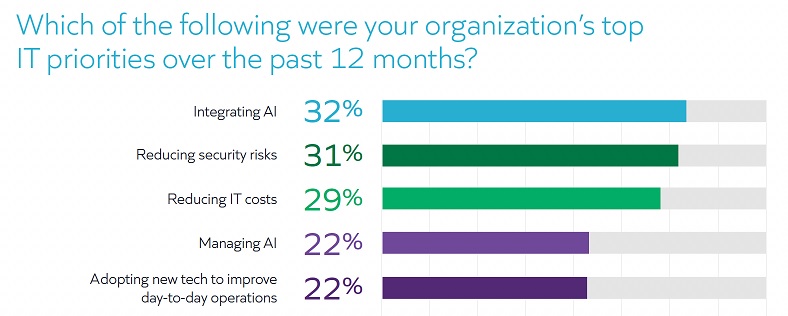Generative AI has recently experienced unprecedented dramatic growth, making it one of the most exciting transformations the tech industry has seen in some time. However, this growth also poses a challenge for tech leaders who will be expected to deliver on the promise of new technology. In 2024, delivering tangible outcomes that meet the potential of AI, and setting up incubator projects for the future will be key tasks.
There can be no doubt that AI software can augment human capabilities to increase productivity and efficiency, which can have an impact on most industries, even highly regulated ones; the opportunity for increased productivity is too great to ignore. The challenge facing many organizations is how to invest in such innovation at a time where pressure on funding remains high.

Productivity Impact
To deliver value in 2024, finding the right pilot projects which harness the power of AI is key. The main use cases today include replacing customer service interactions, summarizing reports, writing personalized marketing content, language translation or generating software code. These areas have solutions already in the market and may represent easy wins that can be shown to deliver outcomes. However, looking at which fundamental changes can bring the most benefit to any organization will take time. While companies are quickly making massive strides forward thanks to AI, these will be the exceptions rather than the norm. Many external vendors are also looking to provide updated service offerings as they make use of AI, and these will likely also lead to productivity gains.
Increased Cybersecurity Risk
According to Snow Software's IT Priorities Report, cybersecurity remains, as it has for many years, a continuing top priority for leaders. In 2024, the only issue more important for IT leaders than cybersecurity is AI and there can be no doubt that sophistication in attacks, particularly those that trick people using social engineering, is only going to increase with new AI-driven powers. Typical cybersecurity training will struggle to be relevant in the face of voicemails using deepfake technology to flawlessly reproduce a leader's voice or phishing emails perfectly written and tailored to the recipient. It should also be expected that fabricated videos will become more prevalent. This will require leaders to enter an arms race of increasing protection to meet the increased level of threats. It is likely that security spending will have to continue to grow during 2024.
Budgetary Implications
Most IT leaders are facing budget pressure, and most have encountered numerous examples of SaaS vendors implementing substantial price increases in 2023 (my personal experience was one supplier who sought to increase prices by 160%). The effects of inflation, rising supplier and vendor costs, and new AI-based services will impact IT budgets, requiring leaders to find innovative ways to cope within constraints.
Consolidating your IT estate is one method of reducing budget pressure. This trend was mirrored in the IT Priorities Report, where 88% of IT leaders reported moving towards platforms and away from point tools. Reducing licenses and rightsizing use are also key for finding room within budgets. This is where IT asset management (ITAM) practices, with the right tools in place, are essential for organizations looking to save on costs. Between cloud, SaaS, unused or over-provisioned licenses and the overall increased complexity within IT environments at most organizations, a significant amount of waste is essentially guaranteed.
This is especially true for the many organizations that have recently undergone mass layoffs or mergers and acquisitions. There are significant opportunities for organizations to save on costs when undergoing transitions, and the insight provided through ITAM could help save significant costs.
The AI Implication for Cloud Costs
The growing usage of public cloud has led to the emergence of the FinOps movement, which is a discipline focused on managing cloud resources effectively. With AWS adopting the FinOps standard, the adoption of FinOps practices and certifications is expected to increase rapidly. Every large organization will have at least one employee working on FinOps practices, with enterprise adoption being the strongest. The larger the cloud bill, the more necessary FinOps will become.
With the rise of AI, we will consume more CPU power, which will drive up cloud bills and add complexity. FinOps strategies, along with ensuring the presence of appropriate business units at the table, will be key for organizations to ensure their cloud spending is constrained to what the company needs.
What's Next?
The next step in the AI journey is likely to be regulation, of both the technology itself and the data that powers it. The speed at which governments have already produced proposed frameworks is indicative of the importance policy makers place on ensuring AI technologies do not operate without guardrails. To maximize beneficial outcomes from transformative technology, we need space for innovation to thrive. It is therefore critical that governments strike the correct balance between safety and innovation, which ensure we can reap the benefits without losing privacy, and whilst protecting intellectual property.
